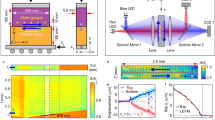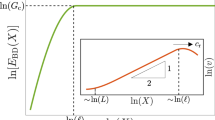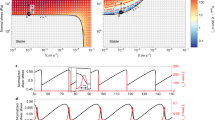Abstract
Rapid rupture fronts—akin to earthquakes—mediate the transition to frictional motion. Once formed, their singular form, dynamics and arrest are well described by fracture mechanics. Ruptures, however, first need to be created within initially rough frictional interfaces. Hence, static friction coefficients are not well defined, with frictional ruptures nucleating over a wide range of applied forces. A critical open question is, therefore, how the nucleation of rupture fronts actually takes place. Here we experimentally show that rupture fronts are preceded by slow nucleation fronts—self-similar entities not described by fracture mechanics. They emerge from initially rough frictional interfaces at a well-defined stress threshold, evolve at the characteristic velocity and timescales governed by stress levels, and propagate within a frictional interface to form the initial rupture from which fracture mechanics take over. These results are of fundamental importance to questions ranging from earthquake nucleation and prediction to processes governing material failure.
This is a preview of subscription content, access via your institution
Access options
Access Nature and 54 other Nature Portfolio journals
Get Nature+, our best-value online-access subscription
$29.99 / 30 days
cancel any time
Subscribe to this journal
Receive 12 print issues and online access
$209.00 per year
only $17.42 per issue
Buy this article
- Purchase on Springer Link
- Instant access to full article PDF
Prices may be subject to local taxes which are calculated during checkout





Similar content being viewed by others
Data availability
Source data for Figs. 2c,d,3a,c,d,4b and 5 are available with this paper. All other data that support the plots within this paper and other findings of this study are available from the corresponding author upon request. The data can also be directly accessed at https://doi.org/10.4121/14697138.v1.
References
Dresen, G., Kwiatek, G., Goebel, T. & Ben-Zion, Y. Seismic and aseismic preparatory processes before large stick–slip failure. Pure Appl. Geophys. https://doi.org/10.1007/s00024-020-02605-x (2020).
Latour, S., Schubnel, A., Nielsen, S., Madariaga, R. & Vinciguerra, S. Characterization of nucleation during laboratory earthquakes. Geophys. Res. Lett. 40, 5064–5069 (2013).
Brener, E. A., Aldam, M., Barras, F., Molinari, J.-F. & Bouchbinder, E. Unstable slip pulses and earthquake nucleation as a nonequilibrium first-order phase transition. Phys. Rev. Lett. 121, 234302 (2018).
Wu, B. S. & McLaskey, G. C. Contained laboratory earthquakes ranging from slow to fast. J. Geophys. Res. Solid Earth 124, 10270–10291 (2019).
Ohnaka, M. & Shen, L. F. Scaling of the shear rupture process from nucleation to dynamic propagation: implications of geometric irregularity of the rupturing surfaces. J. Geophys. Res. Solid Earth 104, 817–844 (1999).
Popov, V. L., Grzemba, B., Starcevic, J. & Fabry, C. Accelerated creep as a precursor of friction instability and earthquake prediction. Phys. Mesomech. 13, 283–291 (2010).
McLaskey, G. C. Earthquake initiation from laboratory observations and implications for foreshocks. J. Geophys. Res. Solid Earth 124, 12882–12904 (2019).
Freund, L. B. Dynamic Fracture Mechanics (Cambridge Univ. Press, 1990).
Ciliberto, S., Guarino, A. & Scorretti, R. The effect of disorder on the fracture nucleation process. Physica D 158, 83–104 (2001).
Ramos, O., Cortet, P.-P., Ciliberto, S. & Vanel, L. Experimental study of the effect of disorder on subcritical crack growth dynamics. Phys. Rev. Lett. 110, 165506 (2013).
Reches, Z. & Lockner, D. A. Nucleation and growth of faults in brittle rocks. J. Geophys. Res. Solid Earth 99, 18159–18173 (1994).
Bowden, F. P. & Tabor, D. The Friction and Lubrication of Solids (Oxford Univ. Press, 2001).
Palmer, A. C. & Rice, J. R. The growth of slip surfaces in the progressive failure of over-consolidated clay. Proc. R. Soc. Lond. A 332, 527–548 (1973).
Barras, F. et al. Emergence of cracklike behavior of frictional rupture: the origin of stress drops. Phys. Rev. X 9, 041043 (2019).
Svetlizky, I., Kammer, D. S., Bayart, E., Cohen, G. & Fineberg, J. Brittle fracture theory predicts the equation of motion of frictional rupture fronts. Phys. Rev. Lett. 118, 125501 (2017).
Kammer, D. S., Svetlizky, I., Cohen, G. & Fineberg, J. The equation of motion for supershear frictional rupture fronts. Sci. Adv. 4, eaat5622 (2018).
Bayart, E., Svetlizky, I. & Fineberg, J. Fracture mechanics determine the lengths of interface ruptures that mediate frictional motion. Nat. Phys. 12, 166–170 (2016).
Bayart, E., Svetlizky, I. & Fineberg, J. Rupture dynamics of heterogeneous frictional interfaces. J. Geophys. Res. Solid Earth 123, 3828–3848 (2018).
Svetlizky, I. & Fineberg, J. Classical shear cracks drive the onset of dry frictional motion. Nature 509, 205–208 (2014).
Svetlizky, I. et al. Properties of the shear stress peak radiated ahead of rapidly accelerating rupture fronts that mediate frictional slip. Proc. Natl Acad. Sci. USA 113, 542–547 (2016).
Mello, M., Bhat, H. S. & Rosakis, A. J. Spatiotemporal properties of sub-Rayleigh and supershear rupture velocity fields: theory and experiments. J. Mech. Phys. Solids 93, 153–181 (2016).
Xu, S., Fukuyama, E. & Yamashita, F. Robust estimation of rupture properties at propagating front of laboratory earthquakes. J. Geophys. Res. Solid Earth 124, 766–787 (2019).
Kammer, D. S. & McLaskey, G. C. Fracture energy estimates from large-scale laboratory earthquakes. Earth Planet. Sci. Lett. 511, 36–43 (2019).
Shlomai, H., Kammer, D. S., Adda-Bedia, M. & Fineberg, J. The onset of the frictional motion of dissimilar materials. Proc. Natl Acad. Sci. USA 117, 13379–13385 (2020).
Passelègue, F. X. et al. Initial effective stress controls the nature of earthquakes. Nat. Commun. 11, 5132 (2020).
Svetizky, I., Albertini, G., Cohen, G., Kammer, D. S. & Fineberg, J. Dynamic fields at the tip of sub-Rayleigh and supershear frictional rupture fronts. J. Mech. Phys. Solids 137, 103826 (2020).
Nielsen, S., Taddeucci, J. & Vinciguerra, S. Experimental observation of stick-slip instability fronts. Geophys. J. Int. 180, 697–702 (2010).
Rubinstein, S. M., Cohen, G. & Fineberg, J. Dynamics of precursors to frictional sliding. Phys. Rev. Lett. 98, 226103 (2007).
Rubinstein, S. M., Cohen, G. & Fineberg, J. Detachment fronts and the onset of dynamic friction. Nature 430, 1005–1009 (2004).
Acosta, M., Passelègue, F. X., Schubnel, A., Madariaga, R. & Violay, M. Can precursory moment release scale with earthquake magnitude? A view from the laboratory. Geophys. Res. Lett. 46, 12927–12937 (2019).
Trømborg, J. K. et al. Slow slip and the transition from fast to slow fronts in the rupture of frictional interfaces. Proc. Natl Acad. Sci. USA 111, 8764–8769 (2014).
de Geus, T. W. J., Popović, M., Ji, W., Rosso, A. & Wyart, M. How collective asperity detachments nucleate slip at frictional interfaces. Proc. Natl Acad. Sci. USA 116, 23977–23983 (2019).
Ben-David, O., Cohen, G. & Fineberg, J. The dynamics of the onset of frictional slip. Science 330, 211–214 (2010).
Ben-David, O. & Fineberg, J. Static friction coefficient is not a material constant. Phys. Rev. Lett. 106, 254301 (2011).
Passelègue, F. X., Schubnel, A., Nielsen, S., Bhat, H. S. & Madariaga, R. From sub-Rayleigh to supershear ruptures during stick-slip experiments on crustal rocks. Science 340, 1208–1211 (2013).
Lapusta, N. & Rice, J. R. Nucleation and early seismic propagation of small and large events in a crustal earthquake model. J. Geophys. Res. Solid Earth 108, 2205 (2003).
Uenishi, K. & Rice, J. R. Universal nucleation length for slip-weakening rupture instability under nonuniform fault loading. J. Geophys. Res. Solid Earth 108, 2042 (2003).
Kato, A. & Ben-Zion, Y. The generation of large earthquakes. Nat. Rev. Earth Environ. 2, 26–39 (2021).
Berman, N., Cohen, G. & Fineberg, J. Dynamics and properties of the cohesive zone in rapid fracture and friction. Phys. Rev. Lett. 125, 125503 (2020).
Ben-David, O., Rubinstein, S. M. & Fineberg, J. Slip-stick and the evolution of frictional strength. Nature 463, 76–79 (2010).
Brodsky, E. E. & van der Elst, N. J. in Annual Review of Earth and Planetary Sciences Vol. 42 (ed. Jeanloz, R.) 317–339 (Annual Reviews, 2014).
Fukuyama, E. et al. Spatiotemporal complexity of 2-D rupture nucleation process observed by direct monitoring during large-scale biaxial rock friction experiments. Tectonophysics 733, 182–192 (2018).
Rice, J. R., Lapusta, N. & Ranjith, K. Rate and state dependent friction and the stability of sliding between elastically deformable solids. J. Mech. Phys. Solids 49, 1865–1898 (2001).
Shlomai, H., Adda-Bedia, M., Arias, R. E. & Fineberg, J. Supershear frictional ruptures along bimaterial interfaces. J. Geophys. Res. Solid Earth 125, e2020JB019829 (2020).
Bayart, E., Svetlizky, I. & Fineberg, J. Slippery but tough: the rapid fracture of lubricated frictional interfaces. Phys. Rev. Lett. 116, 194301 (2016).
Tada, H., Paris, P. C. & Irwin, G. R. The Stress Analysis of Cracks Handbook 3rd edn (ASME Press, 2000); https://doi.org/10.1115/1.801535
Newman, J. C. & Raju, I. S. An empirical stress-intensity factor equation for the surface crack. Eng. Fract. Mech. 15, 185–192 (1981).
Dieterich, J. Modeling of rock friction: 1. Experimental results and constitutive equations. J. Geophys. Res. Solid Earth 84, 2161–2168 (1979).
Rice, J. R. & Ruina, A. L. Stability of steady frictional slipping. J. Appl. Mech. 50, 343–349 (1983).
Baumberger, T., Berthoud, P. & Caroli, C. Physical analysis of the state- and rate-dependent friction law. II. Dynamic friction. Phys. Rev. B 60, 3928–3939 (1999).
Berthoud, P., Baumberger, T., G’Sell, C. & Hiver, J. -M. Physical analysis of the state- and rate-dependent friction law: static friction. Phys. Rev. B 59, 14313–14327 (1999).
Schär, S., Albertini, G. & Kammer, D. S. Nucleation of frictional sliding by coalescence of microslip. Int. J. Solids Struct. 225, 111059 (2021).
Acknowledgements
J.F. and S.G. acknowledge the support of the Israel Science Foundation (grant no. 840/19). We also thank M. Adda-Bedia for his invaluable input and advice.
Author information
Authors and Affiliations
Contributions
S.G. performed the experimental measurements. S.G. and J.F. contributed to the data analysis, experimental design and writing of the manuscript.
Corresponding author
Ethics declarations
Competing interests
The authors declare no competing interests.
Additional information
Peer review information Nature Physics thanks Anders Malthe-Sørenssen and the other, anonymous, reviewer(s) for their contribution to the peer review of this work.
Publisher’s note Springer Nature remains neutral with regard to jurisdictional claims in published maps and institutional affiliations.
Extended data
Extended Data Fig. 1 Fracture energy increase by the marker layer.
a, Schematic description of the experiment. Half of the interface was painted with a marker layer, and the strain signals were measured by a number of rosette type strain gages located about 3.5 mm above the interface. Blue (red) colors correspond to the bare (painted with marker) interface, respectively. b, Comparison of the \({\mathrm{{\Delta}}}{\it{\epsilon }}_{xx}\) (top) and \({\mathrm{{\Delta}}}{\it{\epsilon }}_{yy}\) (bottom) signals of the same rupture front in the bare (blue) and painted (red) regions, respectively. This rupture front propagated at a velocity of 1200 m/s=0.95cR. Superimposed are 3 successive measurements spaced 7mm apart in both the bare (blue) and painted (red) regions. The influence of the marker is evident on the amplitudes. Shown are (top) the \({\mathrm{{\Delta}}}{\it{\epsilon }}_{xx}\) and (bottom) \({\mathrm{{\Delta}}}{\it{\epsilon }}_{yy}\) components, whose respective amplitudes \(\delta {\it{\epsilon }}_{xx}\) and \(\delta {\it{\epsilon }}_{yy}\) are proportional to the instantaneous values of the stress intensity factor, K. c, \(\delta {\it{\epsilon }}_{xx}\) as a function of the rupture velocity in both regions. Each point is an average of 2–10 measurements; the error bars are their standard deviation. Colors denote the painted (red) and bare (blue) sections of the interface. (inset) The resulting fracture energy ratios of painted and bare surfaces. Use of the marker increases Γ on the interface by approximately a factor of 5. Representative green and orange error bars are presented in (a) and (b) for, respectively the painted and bare sections of the interface.
Extended Data Fig. 2 Calculation of theoretical stress intensity factors.
a, Two snapshots of the expanding rupture during the nucleation phase of the event presented in Fig. 3. We can approximate the general shape of the nucleating patch by a semi-elliptical edge crack47, as denoted by the white line. The ellipse’s axis ratio, a/l is approximately 0.85, and remains fairly constant throughout the entire nucleation phase. b, Schematic description of the calculation47 of the stress intensity factor K, of a semi-elliptical edge crack. The parameters w and b used in the calculation are noted. The nucleation patch was assumed to propagate in the x direction. The nucleation point at the center of the ellipse, is located at the center of the initial damage zone, a distance of ξ0/2 from the right edge of the marker. The propagation distance, l(t), used in the calculation is therefore l=ξ(t)-ξ0/2 in terms of the damage zone size, ξ0 and nucleation front location, ξ(t) which are both defined from the barrier edge (Fig. 3a). c, The theoretical stress intensity factor as a function of crack length for the 1D (dashed line) and the elliptical (full line) cases. The stress field used in this example is that denoted by the black line in Fig. 3c, where varr=1160 m/s Note that, experimentally, the onset of dynamic rupture (Fig. 3c) occurred at a length l=4 mm, which agrees well with the predicted value (l=3.9) for LG. The dotted line denotes the critical stress intensity factor, Kc, above which stationary cracks are unstable.
Extended Data Fig. 3 Comparison of theoretical and measured Griffith lengths.
Compared are the calculated Griffith lengths, LG with the measured distances of nucleation lengths, ξ(τ) from the nucleation locations, ξ0/2. The data shown correspond to the red data within Fig. 5a, in which nucleation fronts triggered rapid rupture fronts.
Rights and permissions
About this article
Cite this article
Gvirtzman, S., Fineberg, J. Nucleation fronts ignite the interface rupture that initiates frictional motion. Nat. Phys. 17, 1037–1042 (2021). https://doi.org/10.1038/s41567-021-01299-9
Received:
Revised:
Accepted:
Published:
Issue Date:
DOI: https://doi.org/10.1038/s41567-021-01299-9
This article is cited by
-
Control of Static Friction by Designing Grooves on Friction Surface
Tribology Letters (2024)
-
Static friction coefficient depends on the external pressure and block shape due to precursor slip
Scientific Reports (2023)
-
How frictional slip evolves
Nature Communications (2023)
-
A Synthesis of Fracture, Friction and Damage Processes in Earthquake Rupture Zones
Pure and Applied Geophysics (2022)
-
Investigation of Contact Clusters Between Rough Surfaces
Tribology Letters (2022)



